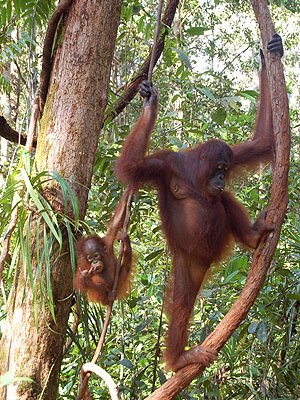
The University of Queensland has found paying to preserve carbon stored in forests could protect endangered wildlife such as Indonesia’s orangutans.
UQ PhD student Oscar Venter is the lead author of the study “Carbon Payments as a Safeguard for Threatened Tropical Mammals,” published in the current edition of the journal Conservation Letters.
The study concentrated on 3.3 million hectares of tropical forest in Kalimantan (Indonesian Borneo), which is home to orangutans, elephants and other endangered species.
Based on prices now being paid for carbon dioxide (CO2), the study compared the revenue that could be derived from protecting the forest and avoiding carbon emissions to the revenue that would be derived if the forest was converted to oil palm plantations.
Mr Venter said the study found that carbon payments, in the form of payments for Reduced Emissions from Deforestation and forest Degradation (REDD) could compete with oil palm at carbon prices of $10 to $33 per tonne of CO2.
He said if REDD was only used to protect the most carbon rich areas, which would still be a great win for forest conservation, the price of CO2 would drop dramatically, down to as low as $2 per tonne.
“What excites me most about our results is that those areas that are particularly good for carbon and therefore most likely to receive REDD protection, also house very high levels of threatened mammals, almost twice the average number,” he said.
“Countries with tropical forests, such as Indonesia, are pushing hard to develop. Part of this development involves clearing forests to make room for agriculture.
“To them this makes sense, standing forests have had no value in the past, you can’t sell orangutans and elephants on conservation markets, they don’t exist. But carbon markets do exist and they traded US $126 billion in 2008.
“If REDD is successful at harvesting some of these funds to protect tropical forests by giving them value, this could fundamentally change conservation in these countries, and provide benefits for mammals at a scale that we’ve never before seen.”
Furthermore, the study discovered forest conservation in Kalimantan would prevent 2.1 billion tonnes of carbon emissions.
The collaborative study includes researchers from the Center for International Forestry Research (CIFOR), one of 15 centres supported by the Consultative Group on International Agricultural Research (CGIAR), as well as scientists from UQ, The Nature Conservancy and the Great Ape Trust of Iowa.
The proposals to use carbon payments to conserve forests is expected to be highlighted at The United Nations Climate Change Conference scheduled for December in Copenhagen.
Mr Venter said he was working with The Nature Conservancy in Indonesia to help plan for and implement REDD in areas that are slated for oil palm, as well as logging concessions and forest-protected areas.
“By showing how much value could come from carbon payments, it becomes easier to demonstrate the benefits of shifting oil palm expansion to areas that have no forests or only have degraded forests, which contain less carbon and are less biologically diverse,” he said.
CIFOR Director General Frances Seymour said REDD offered important win-win opportunities for climate and biodiversity protection.
“Ultimately, our goal is to help fashion an agreement in Copenhagen that will allow tropical forests to become a part of a more comprehensive climate agreement – one that will reduce emissions as well as produce co-benefits,” Mr Seymour said.
“There is already a good case to be made for ending the exclusion of existing forests in the next climate pact. This new evidence shows just one of the many benefits that a REDD accord could have.”
Media: Mr Oscar Venter on (0404 967 271 or 07 3310 4756) or Eliza Plant at UQ Communications (07 3365 2619)
* High resolution images are available for download from here*
.jpg)



